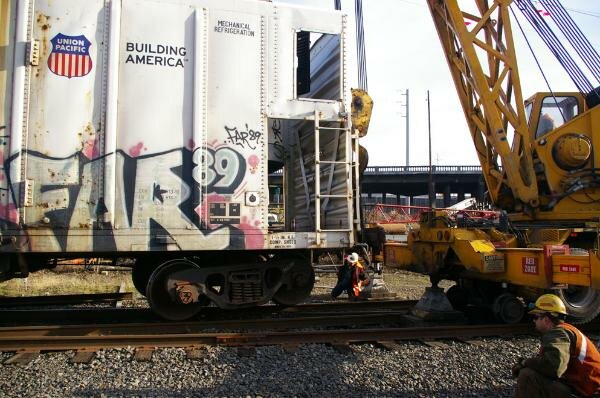| Last Update: December 20, 2009 |
| History of the OPR - East Portland Branch - Molalla Branch - Videos of the OPR in Action News & Upcoming Events - Photos of Past Events - Roster of the OPR Special Features |
| History of the OPR - East Portland Branch - Molalla Branch - Videos of the OPR in Action News & Upcoming Events - Photos of Past Events - Roster of the OPR Special Features |
| In December, 2009 a reefer car went on the ground in the OPR's East Portland Yard. The cause of the derailment was running through a switch, which caused one truck of one refrigerator car to go on the ground. This derailment also damaged rail and ties which had to be repaired. While many cars can be blocked back onto the rails, the nature of this derailment required the use of a crane. This special feature shows how the car was rerailed and how the OPR crew replaced a rail and fixed the track in a matter of only a few hours. |
| Union Pacific had to bring out a hy-rail crane to lift the car back onto good rail. Once the crane was on the rails in front of the car, the crane was maneuvered into place. |
| Copyright © 2004-2010 All Rights Reserved Webmaster Brian McCamish Oregon Pacific Railroad Webmaster |
| UP no longer lifts cars by the coupler, as was common practice in the past, due to the damage it can do the coupler. However due to the nature of the design of this car and equipment on hand, the UP crew obtained special permission to use that method in this circumstance. |
| Using the crane and a coupler lift to lift the car off the ground and onto a good section of rail. The truck was chained to the car body to prevent it from falling off when lifted off the ground. |
| With the car back on good track, the crane ties up and departs. The 1202 moves the refrigerator car out of the way so track repairs can be made on the bad side of the switch. |
| With the bad rail already cut out, Brian and Craig Samuels measure the section of rail to be replaced. Tim Samuels operates the compact Excavator to maneuver the new piece of rail in place. Craig Samuels pulls spikes. Brian Samuels installs spike plugs. |
| Tim Samuels lifts a new rail into place. Brian and Craig Samuels aligns the new rail into the switch frog. Brian Samuels cuts out a section of the old rail to allow the new rail to fit, using a hydraulic saw. Tim Samuels then lifts the cut piece out of the way. |
| Craig and Tim Samuels install spike plugs. Brian Samuels aligns a special hydraulic bolt hole drill. This drill will create the bolt holes for the rail joiner. |
| New bolt holes in the rail. Brian and Craig Samuels use a hydraulic wrench to install and torque the rail joiner bolts. The new rail is then aligned with an alignment bar and spiked into place. |
| 1202 with empties preparing to depart Milwualkie for East Portland on the day of the derailment |
| View of the derailed car. A loaded refrigerator car. Only the front truck is derailed after splitting a switch. However a rail is damaged and the locomotive is in front of the derailment, making blocking the car back onto good rail, impossible. |
| Brian Samuels cuts out the bad rail and sets the remaining good portion of the rail back onto its tie plates. The 1202 is moved out of the way with empty cars waiting to go into the interchange once the repairs are made. |


| How Rerail a Reefer Car |
| With the car rerailed and the rail replaced, the 1202 set out the empties into the interchange. The loads were then taken to Milwuakie. |



















































